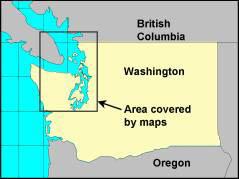
English sole
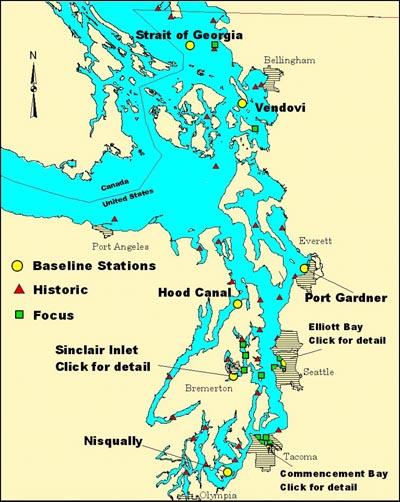
Baseline Stations
Baseline stations are classified as "urban", "near-urban" or "non-urban", based on their proximity to urban centers or industrialized areas. Because of the complex, unmeasurable factors associated with describing the contaminant-condition of sediments, we use this subjective classification scheme. The urban locations represent some of the largest cites along the Puget Sound shoreline. The non-urban areas are situated far from these cites, greater than 10 km and often separated by deep basins. Near-urban locations are between urban and non-urban.
Where possible, monitoring stations were located near sediment quality stations (sampled by the Department of Ecology) to facilitate correlation of sediment chemistry with muscle tissue chemistry.
Focus Stations
Focus studies have been carried out in Elliott Bay, Commencement Bay and Sinclair Inlet to further characterize the areal extent of contamination and associated biological effects in English sole. Focus stations were distributed so as to expand the spatial coverage around the baseline station of interest. Click the preceding station names for detailed maps of the Focus Study sites.
Historic Stations
Historic stations are those at which PSAMP has discontinued sampling.
Mussels
2019-20 mussel monitoring cage locations
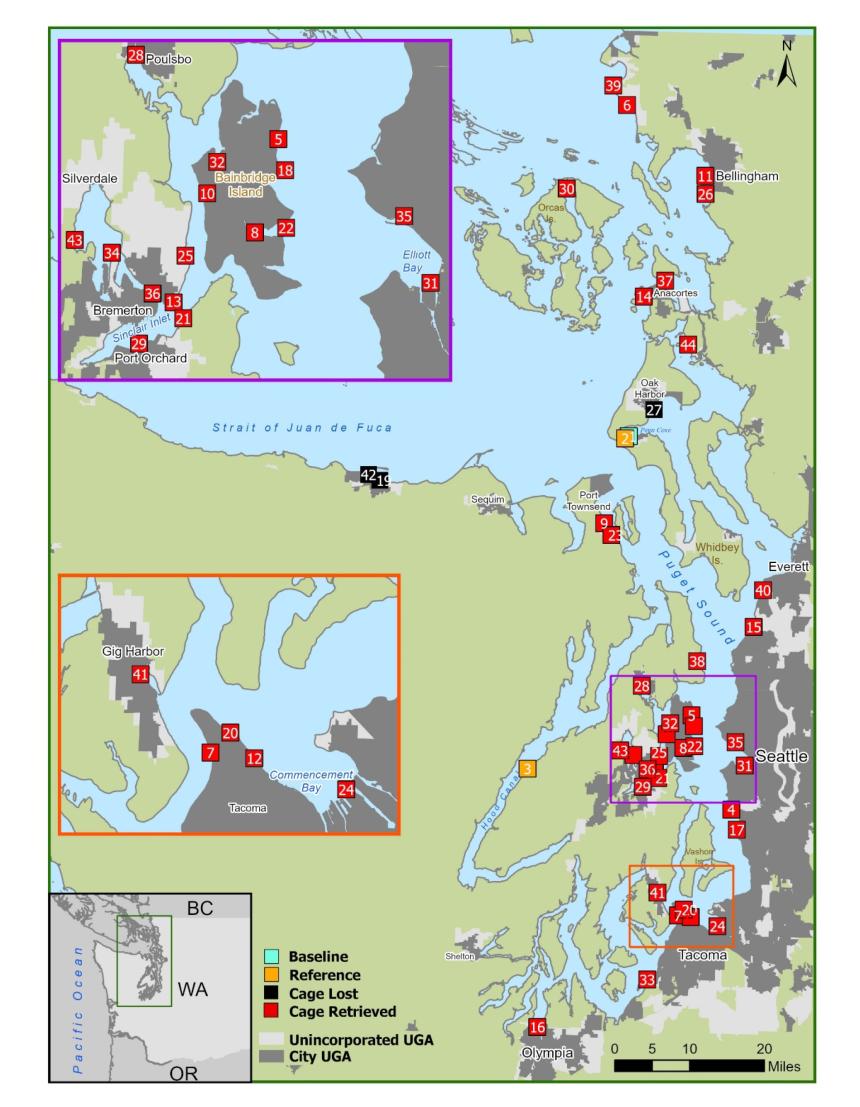
Pacific herring
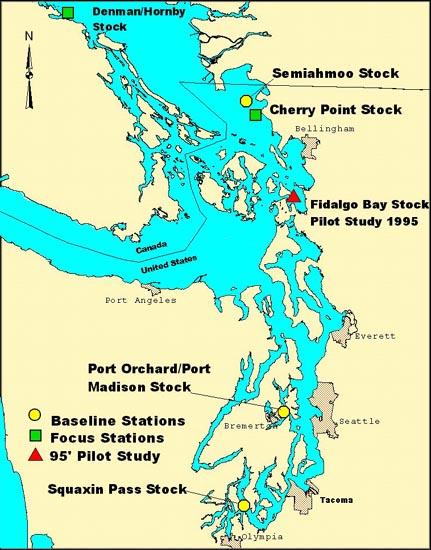
Baseline Stations
Distinct stocks of Pacific herring are monitored at 3 pre-spawning locations: Semiahmoo in the Strait of Georgia (northern Puget Sound), Port Orchard in central Puget Sound and Squaxin Pass in southern Puget Sound. The fish are sampled from pre-spawning aggregates near known spawning grounds, so the sampling locations vary somewhat from year to year.
Focus Stations
In 2000, concerns over major declines in the abundance of the Cherry Point herring stock prompted a focus study to examine the possibility that contaminants are affecting their survival. Adult males, egg skeins from mature females, and spawned eggs were collected in the Cherry Point area to compare against those collected at other Puget Sound stations.
Juvenile Chinook
Toxic contaminant exposure is a contributing factor in the decline of Puget Sound Chinook salmon, which are listed as threatened under the Endangered Species Act (ESA). During their seaward migration, juvenile Chinook salmon rear and feed for extended periods in estuary and nearshore habitats, potentially exposing them to elevated levels of contaminants that are often present in these areas. Indeed, many of Puget Sound’s rivers flow through highly developed urban areas where juvenile Chinook salmon are at a higher risk of being exposed to harmful levels of contaminants. Exposure to contaminants can lead to reduced growth, a weakened immune response, reproductive impairment, and may ultimately reduce the likelihood of Chinook salmon survival. TBiOS monitors contaminants in juvenile Chinook salmon to track changes in contaminant levels and monitor their health as they migrate through rivers, estuaries, nearshore, and offshore habitats within Puget Sound.
Pilot, exploratory sampling of toxic chemicals in juvenile Puget Sound Chinook salmon by TBiOS began in 2013 in five river-estuary systems representing a range of non-urban to urban landscapes: the Skagit, Snohomish, Green/Duwamish, Puyallup/White, and Nisqually rivers. That same year, samples were also collected from sites in the deeper offshore marine basins of Puget Sound. The sampling area was expanded to 12 locations in 2016 across a wider range of urban to non-urban landscapes, covering most major river estuaries of Puget Sound, the Strait of Juan de Fuca, and Lake Washington. A detailed study focused on the Green/Duwamish River and Elliott Bay took place in 2018. In 2021 and 2023, surveys were done in a subset of Puget Sound estuaries in addition to a detailed study focused on the Puyallup and White River watershed and Commencement Bay. Most recently, a survey in nine river estuaries and Lake Washington was completed in spring 2024. Collectively, juvenile Chinook salmon have been collected from 12 major river systems, representing 22 ESA-listed Puget Sound Chinook salmon populations.
Shortly after monitoring began, the Puget Sound Partnership adopted the Contaminants in Juvenile Chinook Salmon as art of the Puget Sound Toxics in Aquatic Life Vital Sign. This indicator was adopted to help monitor the health of the river estuary and nearshore habitats and measure progress toward recovery goals. Beginning with the 2016 study, data from these surveys have been included in the Puget Sound Toxics in Aquatic Life Vital Sign.
Ongoing toxics monitoring has determined some juvenile Chinook salmon are being exposed to contaminant levels high enough to potentially impact their health during their seaward migration. Concentrations of PCBs and PBDEs were highest and sometimes above critical body residues (CBRs) in juvenile Chinook salmon migrating through the more developed areas of Puget Sound, including the estuaries of the Snohomish (PCBs and PBDEs), Sammamish/Cedar (PCBs), Green/Duwamish (PCBs and PBDEs), Puyallup/White (PCBs and PBDEs) and Nisqually (PCBs) rivers. Juvenile Chinook salmon in the adjacent nearshore habitat of the Snohomish (i.e., Possession Sound), Sammamish/Cedar (i.e., Shilshole/Salmon Bay area), Green/Duwamish (i.e., Elliott Bay), and Puyallup/White (i.e., Commencement Bay) Rivers also had PCB and PBDE concentrations above CBRs. Furthermore, juvenile Chinook salmon continue to be impacted by these contaminants in the offshore marine environment of Whidbey Basin (PCBs), Central (PCBs and PBDEs) and South Puget Sound (PCBs). Overall, juvenile Chinook salmon sampled from multiple areas exceeded PCB CBRs for reduced growth and mortality, and PBDE CBRs for increased disease susceptibility and altered thyroid function.
As the juvenile Chinook salmon are being exposed to more contaminants than just PCBs and PBDEs, these impacts are likely an underestimation of the health effects the fish are actually experiencing during their seaward migration. In addition to legacy contaminants, juvenile Chinook salmon are being exposed to pharmaceuticals, personal care products, industrial chemicals, and other chemicals of emerging concern which could cause combined negative health effects. Ultimately, reductions in juvenile Chinook salmon survival caused by contaminant exposure may lower abundance of returning adult Chinook salmon to Puget Sound, impacting cultural practices and limiting recreational, commercial, and subsistence fisheries in addition to reducing the food supply of ESA-endangered Southern Resident killer whales. Monitoring contaminant exposure in juvenile Chinook salmon along their migratory pathway allows us to identify hot spots in need of remediation to improve salmon health.
Adult Chinook
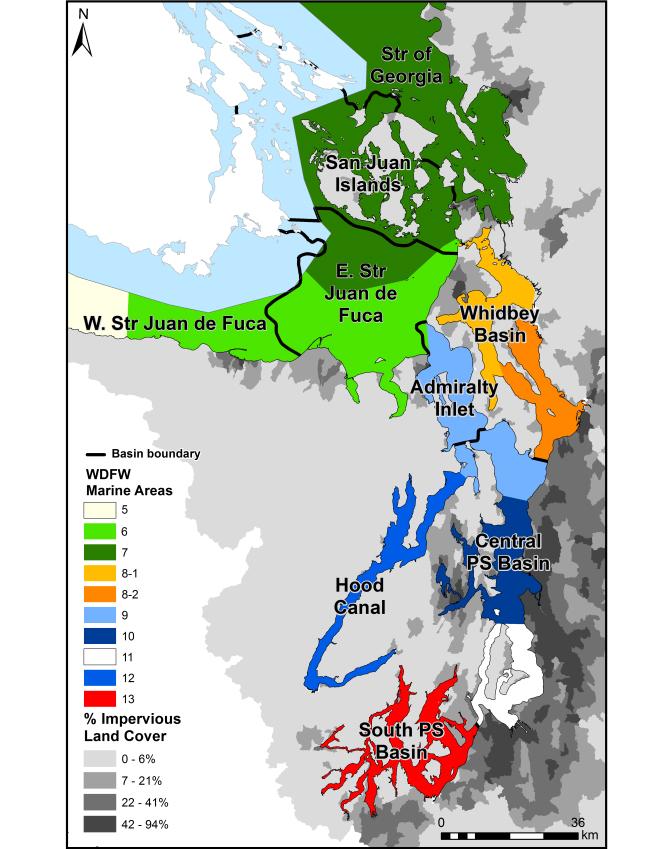
Past TBiOS studies of Pacific Salmon (Chinook and coho) focused on measuring contaminant exposure in adults returning to their natal streams. Fish were collected from terminal “in-river” fisheries at five baseline stations ranging from the Nooksack River in the north to the Deschutes River in the south. Currently, these studies are not a regular part of the TBiOS monitoring plan but may occasionally take place in the future.
Most recently, in 2016 and 2017, resident Chinook salmon (e.g. Blackmouth) were collected by recreational anglers and a tribal test fishery from eight of ten WDFW Marine Areas (MAs) in Puget Sound, roughly corresponding to Puget Sound oceanographic basins (see map). Muscle samples from the Chinook salmon were analyzed for a wide range of persistent organic pollutants (POPs).
Data from the 2016/2017 study were included in the Contaminants in Adult Chinook indicator of the Puget Sound Toxics in Aquatic Life Vital Sign. The Puget Sound Partnership adopted these Vital Signs and indicators to monitor the health of the Puget Sound ecosystem and measure the progress toward recovery goals.

